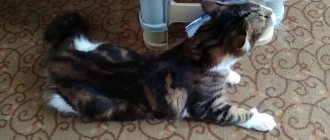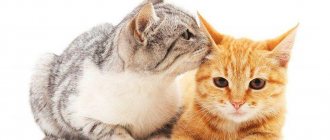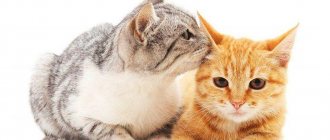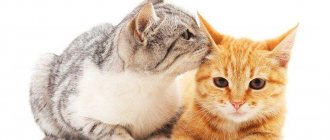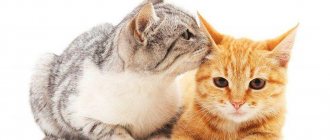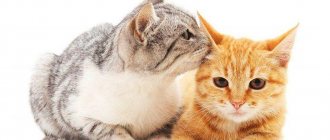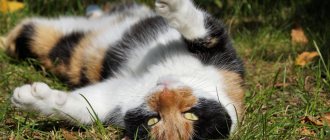When a cat begins to ask for a cat, the owner who has encountered this for the first time is very worried. After all, during sexual heat, the pet screams wildly and behaves inappropriately. Not every person is able to remain calm; many are looking for any ways to calm it down. Folk remedies, sedative pills and even hormonal drugs are used.
Let's find out which methods of suppressing the symptoms of estrus are safe for cats and why you should decide to sterilize.
At what age does a cat start walking?
Cats start yelling at different ages. In some animals, puberty occurs earlier, in others - later. This depends on many factors:
- breed affiliation;
- fatness;
- conditions of detention;
- pet's temperament;
- heredity.
The first time a cat begins to ask for a cat is when mature eggs are already being produced in her ovaries. In most cases, sexual heat begins between 6 and 10 months, but there are exceptions.
In any case, mating during the first few heats is not advisable. After all, for the body to fully form and strengthen, it needs more time.
It is extremely rare for cats to start asking for a cat at the age of 5 months. Such early maturation indicates the presence of health problems. In this case, it is advisable to show the animal to a veterinarian. You will also need to consult a specialist if your first heat starts after a year.
How to prevent pregnancy in a nursing cat
If the cat does not participate in breeding, and its offspring are not of particular financial interest to the owner, it is advisable to sterilize the animal. The best time for this is after 6 months - 1 year. Theoretically, it is possible to perform surgery on a nursing mother cat to prevent her from becoming pregnant again. If sterilization is undesirable, you can give your pet sedative medications based on medicinal herbs (such as “Cat Bayun”, “Fitex”). You also need to monitor your nursing cat, especially if she goes into heat soon after pregnancy. That is, it is necessary to exclude contacts between the female pet and cats.
You should not use alcohol tincture or valerian tablets as a natural sedative. This remedy for pets is a drug that puts them in a state of extreme excitement. That is, a cat who has started to heat, after a small amount of valerian solution or tablets, will have one goal - to quickly connect with the cat. The existing kittens will naturally go to the side.
Also, hormonal drugs that suppress sexual desire are also extremely undesirable for calming a nursing pet. Products of this type (“Sex barrier”, “Contrasex”, etc.) have a lot of contraindications, and they cannot be used by cats during lactation.
Symptoms of estrus
It's impossible not to notice when a cat asks for a date with a cat. Signs by which you can determine that your pet has gone on a spree:
- The cat screams and meows protractedly at the top of her voice. Some owners get scared - they think she is sick. In fact, this is a natural process. The female attracts potential suitors with a loud cry.
- When a cat asks for a cat, she leaves marks in the house. It is unknown whether she does this on purpose or not. The fact is that during the hunting period a special mucous secretion is released from the vulva. In nature, its smell attracts cats.
- The cat becomes very affectionate, gentle, constantly rubs against the owner’s legs and purrs. In rare cases, the pet behaves in the opposite way - it becomes irritable and aggressive.
- The urge to urinate becomes more frequent.
- When a cat asks for a cat, she takes a characteristic pose - arching her back and raising her butt. The tail is moved to the side. In this way, the female shows the male that she is ready for mating.
- It is easy to understand that a cat wants a cat by its loss of appetite. The pet rarely approaches the food bowl and eats little. Some individuals generally lose interest in food, they even refuse their favorite treat.
You should not worry about the cat’s well-being during this period - when the heat ends, everything will return to normal. The behavior will become habitual, an appetite will appear, and the pet will stop behaving inappropriately.
Duration and frequency of sexual heat
The length of the period during which cats ask for a cat differs from individual to individual. On average, estrus lasts 7-10 days.
The period of sexual hunting can be divided into several stages. Each of them has certain characteristics:
- Proestrus. The cat begins to ask for a cat, but at the same time she is not yet ready for effective mating. Her estrogen levels increase. Sexual heat begins - the external genitalia increase slightly in size, and transparent discharge appears from the vulva. Behavior changes - the cat rubs against objects for a long time, requires more attention and affection. Appetite decreases. The duration of proestrus is 2-3 days.
- Estrus. The cat is already ready for mating. If she has a date with a cat during this period, she is more likely to get pregnant. The pet feels increasing excitement, this is eloquently evidenced by her behavior - loud inviting cries, adoption of a characteristic pose for mating. The duration of estrus is 3-4 days, in some individuals it lasts longer.
- Metestrus. The level of estrogen in the cat’s body decreases, and along with it, interest in representatives of the opposite sex disappears. Some females even feel irritated at the sight of a male. The cat no longer asks the cat, does not allow him to approach, drives him away with hiss.
- Anestrus. At this stage, the hormonal levels stabilize and the cat calms down.
The frequency of the onset of estrus differs between domestic and wild animals. This process is influenced by the length of daylight hours, quality of nutrition, breed and other factors.
On average, cats ask for a male cat every 3-4 weeks, provided that mating has not occurred.
General information
So, as we have already indicated above, cats belong to the category of very prolific animals. More precisely, small cats. This is not surprising, since the species tries to maintain its optimal numbers in this way. If you look at “orphan” animals, then without any surprise you can reveal that out of a dozen kittens born, barely two or three individuals survive to the age of one year . And this is in the relatively comfortable conditions of modern megacities, where homeless cats have no problems with food.
In more severe natural conditions, “debit and credit” may generally converge in a negative proportion. Predators, climate, and other unfavorable factors can lead to the death of not only the entire litter, but also the mother herself. All this leads to the fact that the cat’s body is programmed by nature for maximum productivity. It is for this reason that the cat begins to walk (or rather, can begin) almost immediately after giving birth.
But if in natural conditions such fertility is more than justified, then in domestic conditions it is not so much. Moreover, this leads to numerous problems, which we will write about below.
How long after giving birth does estrus occur?
The frequency of sexual estrus depends on whether pregnancy has occurred. If a cat has a date with a cat, then she bears the offspring for about 2 months, and then feeds them. Then the next estrus begins 30-50 days after lambing or 10-14 days after the end of lactation. In the wild, cats go into heat on average 2-3 times a year. If there was no mating, then the next time the estrus will begin in 3-4 weeks.
In rare cases, nursing cats ask for a male cat as early as 2 weeks after lambing. If mating does not occur during this period, the next estrus will begin again after 14-21 days.
If the date with the male takes place, then a new pregnancy will not occur, since the uterus has not yet had time to recover and the process of feeding the kittens is underway. But mating during the next heat is more likely to be effective.
Number of births per year
Veterinarians and breeders (people involved in breeding new breeds) are confident that a normal animal should not give birth more than 1.5 times every 3 years . This means that on average a cat should not have more than one birth per year.
Otherwise, the pet will quickly become exhausted, and the body will be subject to various pathological processes. Life expectancy decreases, each subsequent offspring will be weak, painful and non-viable. A cat may develop malignant neoplasms in the mammary glands and genitals.
Behavior problems
When cats ask for a date with a cat, household members have a hard time. The constant screaming makes it impossible to sleep at night. Some people can’t stand it and lock their pets in one of the rooms. Others wet the animal’s fur with water in the evenings. This allows you to gain an hour of silence while the cat licks its fur coat. But as soon as she dries up, she starts asking for the cat again. This behavior is exhausting and forces you to try different ways.
Is it possible to calm a cat at home?
Simply petting and calming a cat that asks for a cat is unlikely to work. You will have to be patient and wait until the heat ends.
Numerous “folk” tips on how to calm a pet usually turn out to be ineffective:
- Pet your pet more often. Showing attention will only increase arousal.
- Give sedatives. They will not help because the animal is not stressed. They are driven by the instinct of reproduction. Such medications only slightly dull the desire to mate.
- Feed the cat with products containing pheromones like Feliway. During sexual hunting they are completely useless. Such drugs help to quickly adapt to a new place and to endure the trip more calmly, but they do not pacify natural instincts.
Calming medications for cats
Sometimes veterinarians recommend taking sedatives. Such medications help to dull arousal a little, but their main purpose is to achieve mental lability, eliminate aggression and anxiety.
List of drugs and method of use:
- Cat Baiyun. A medicine based on herbs with a sedative effect - valerian roots, oregano, sweet clover, mint, motherwort, hop cones and others. As soon as the cat begins to ask for a cat, she is given 2 ml of medicine three times a day for 5-7 days.
- Fitex drops. A sedative with herbal components – valerian, motherwort, hop extract. The medicine normalizes the functioning of the central nervous system, muffles the feeling of fear and aggression. If a cat wants a cat, or vice versa, then the pet is given 3-5 drops of the product in the morning, lunch and evening for several days.
- Drops for cats Stop stress. The drug is available in the form of drops and tablets. The medicine contains aminophenylbutyric acid and extracts of valerian, catnip, hops and motherwort. This remedy helps reduce agitation and correct the animal's behavior in stressful situations. Directions for use: 1 drop per 1 kg of weight twice a day.
Sedatives should not be given to a cat for a long time. They are allowed to be used for no more than 10 days. And you should not expect that these medications will completely eliminate sexual arousal. They can only slightly smooth out the symptoms of estrus.
Artificial ovulation
Sometimes the safest and most effective way to calm a cat so that she does not ask for a cat is to artificially induce ovulation. This method is suitable if the pet cannot be given for mating right now for some reason. For example, if she is in her first heat or a worthy candidate for mating has not yet been found.
In some cases, veterinarians show owners how to simulate sexual intercourse at home, which will cause ovulation. To do this, you will need a small phallic-shaped object about 4-5 mm thick and 1.5-2 cm long. A cotton swab wrapped in a fingertip or something similar will do. The cat is held by the withers. When she is in the mating position, the object is gently inserted into her vagina.
It is recommended to repeat this procedure 3-4 times within 12 hours. After this, the pet should ovulate, which will provoke a false pregnancy.
The heat will stop, the cat will calm down, stop asking for the cat and will prepare for the appearance of kittens. Some females begin to arrange a place for birth. During a false pregnancy, hormonal changes occur, so milk may be released from the mammary glands.
Attention! The artificial ovulation technique cannot be used every time the cat asks for a cat. This can cause inflammation in the uterus.
What not to do
Some actions of owners can harm the cat. For example, you cannot lock an animal in a cellar or bathroom. Being alone will have a negative impact on your mental health.
It is also undesirable to let your cat outside unattended, because it could get hit by a car, contract a virus, or become a victim of aggressive dogs. In addition, uncontrolled walking during estrus can lead to mating with an outdoor cat.
You should not punish her, yell at her, or hit her. This will not help solve the problem, because the animal is at the mercy of instincts. The pet will still continue to scream and roll on the floor.
conclusions
People who own cats should be aware that after giving birth the cat may go into heat. If you follow the deadlines for the period intended for rehabilitation, this will not only help preserve the health of the feline representative, but also wait for full-fledged offspring in the form of healthy kittens.
Thus, the conclusion is this: a nursing cat, and the owners need to draw certain conclusions: allow pregnancy or prevent it.
When a fluffy, uncastrated young beauty lives in the house, sooner or later the owner is puzzled by the question of what time the cat can become pregnant. Knowledge in the field of physiology, understanding of the characteristics of sexual behavior, and the nuances of reproduction will help you competently approach the problem of keeping and breeding a pet.
The cat family is distinguished by its early maturity and fertility. This is also true for pets. A number of factors will influence when a cat can become pregnant for the first time:
- individual characteristics,
The average cat is in her first heat. and with it the opportunity to become pregnant occurs at 6 - 8 months. Later, large breeds and those with long coats mature. In representatives of such breeds as Maine Coon, bobtail, Siberian, Norwegian forest cat, the first heat occurs at 12 - 14 months.
Large breeds of cats mature later, their first heat occurs at 12-14 months
From the moment of the first heat, the pet is physiologically ready to become a mother and retains this ability for almost the entire adulthood. There is no such thing as menopause in the cat family. The reproductive period begins with the first heat and can last until death. Owners of furry pets should be aware of this feature in order to understand that the answer to the question of how many months a cat can become pregnant is quite simple - immediately after puberty.
The task of the animal owner is first and foremost to preserve the health of the pet. That is why experienced breeders and veterinary specialists believe that the first estrus should under no circumstances result in the animal becoming pregnant. A young body must get stronger and take shape. Pregnancy, childbirth and feeding offspring require a lot of effort.
Breeding experts and veterinarians recommend skipping the first 2 - 3 heats, and only after that organize mating. For this purpose, an experienced (untied) cat is selected.
After giving birth, a cat usually comes into heat within 1.5 - 2 months. Often signs of heat are observed earlier - 2 weeks after lambing. However, you should plan your next pregnancy no earlier than 5–6 months. Even if the previous lambing and birth passed without complications, the pet must regain strength. Carrying kittens
, labor activity is associated with large losses of nutrients and minerals. The mother loses a lot of calcium, phosphorus, and vitamins, giving these and other components to the formation of the offspring. In addition, the female should regain her weight and normalize her hormonal levels.
In this regard, responsible and competent breeders recommend planning the birth of a purebred pet no more than once every 1 - 1.5 years. This interval between births will allow you to restore strength and improve your health for the next pregnancy.
It is no coincidence that the cat family is considered one of the most prolific. This fully applies to home beauties. Over the course of a year, a sexually mature cat can give birth 4 to 5 times. This frequency is typical for animals with free access to the street. In the absence of control over sexual behavior, pregnancy can occur even in a nursing cat. This leads to exhaustion, weight loss, curvature of the spine, and the development of inflammatory diseases of the reproductive organs.
If the owner approaches breeding issues responsibly, he will not allow her to become pregnant during every heat. There should be a rehabilitation period of at least 4 to 5 months between births.
Many owners, interested in breeding issues, want to know when cats stop giving birth. The peculiarities of the sexual behavior of domestic beauties allow them to continue their feline lineage throughout their lives, until very old age. Older pets usually give birth to fewer kittens than young animals. Nevertheless, pregnancy also occurs in an older cat by cat standards.
The owner must take a responsible approach to breeding issues and not allow mating of animals older than 7 years. Once your pet reaches this age, she should be sterilized. This point of view is shared not only by veterinary specialists, but also by experienced and competent breeders. No self-respecting breeder will produce offspring from a cat older than 6-7 years.
Contraceptive injection
The above hormonal drugs are available in various forms: tablets, drops, suspensions. The principle of their action is based on suppressing sexual desire and preventing ovulation. Veterinary experts do not recommend the uncontrolled use of oral contraceptives in cats. Owners should be aware that these drugs often cause the development of a dangerous disease for the animal - pyometra.
There is also a contraceptive in the form of an injection - “Covinan”. This hormonal drug eliminates the animal's estrus for about six months. A special feature of the drug is its use before symptoms of estrus are detected. The injection is performed at a veterinary institution according to a specific scheme. Like all hormonal contraceptives, Covinan also has contraindications and increases the risk of developing pathologies of the reproductive system.
A loving and responsible owner of a furry beauty should know not only what time cats can give birth, but also many other issues related to breeding. It is important to remember that the animal needs a rehabilitation period between births, and that cats over 7 years old are not recommended to have offspring. A competent attitude of the owner to breeding issues will ensure the health and long happy life of the animal.
Interrupting estrus with hormonal drugs
Estrus can be prevented or interrupted with the help of hormonal medications. However, they should not be used often, as this will lead to health problems.
List of drugs to suppress sexual arousal in cats:
- Sex Barrier;
- EX-5;
- EX-5T;
- Four with a tail.
Hormonal drugs are designed to reduce the level of estrogen, which will reduce the manifestations of sexual desire. Essentially, taking such medications moves the animal from proestrus to anestrus.
Pros of taking hormonal drugs:
- the cat does not ask the cat, its behavior does not cause inconvenience to the owner;
- it is possible to skip 1-2 matings if the animal is used for breeding, but mating is not possible at the moment.
There are just as many disadvantages to taking hormonal medications. This needs to be understood when deciding whether to give them to your pet:
- such medications cannot be used frequently and for a long time;
- taking them disrupts hormonal levels, and this can lead to serious illnesses - the development of pathologies in the uterus and oncology.
Problems do not appear immediately after taking hormonal drugs. Most often they occur at the age of 3-4 years. If a cat develops endometritis or other diseases of the reproductive system, it will have to resort to castration.
What to do if your pet goes on a spree?
Firstly, be mentally prepared for the need to feed kittens on your own. Practice, unfortunately, proves that such cats almost always lose milk. This is due to a sharp change in hormonal levels. The released compounds block the synthesis of prolactin, that is, the hormone responsible for milk production. Accordingly, the kittens are left without their natural food.
Let us immediately warn you that you should never use cow or goat milk to feed babies, since their characteristics are very different from cat milk and often cause severe digestive disorders. And for small kittens the latter are deadly.
Secondly, under no circumstances use hormonal medications to stop estrus . The body of an animal that has gone into heat immediately after birth is already experiencing powerful overloads. There is no need to aggravate the matter with an influx of “third-party” hormones of synthetic origin. In such cases, the matter may end in oncology.
Consult your veterinarian and choose more gentle sedative drugs on a natural basis. They will allow you and your cat to safely survive the hunting period.
Sterilization
To get rid of your pet’s meticulous screams forever, it is recommended to carry out a sterilization procedure. This method is suitable only for those who do not want to breed cats.
Veterinarians now recommend neutering rather than a simple tubal ligation. This is an abdominal operation to remove the uterus and ovaries. It is done under general anesthesia.
The appropriate age for surgery is when cats start begging for the first time. That is, approximately 6-7 months. It is advisable to have the operation done before the first heat.
Pros and cons of castration:
| pros | Minuses |
| The lifespan of a cat increases by 1.5-2 years | Since the operation is performed under general anesthesia, there is a possibility of complications. |
| The cat does not yell, behaves calmly, does not cause inconvenience to the owner | |
| There is no need to look for partners for mating and think about where to put the kittens | |
| The pet's risk of developing mammary gland cancer, ovarian and uterine pathologies is reduced |
The case for castration also holds true for males. In addition to the fact that cats start screaming when they ask for a cat, they leave marks in the apartment with a pungent musky odor. Rather than endure this, it is better to have surgery and forget about sleepless nights. Today this is the most effective way to solve the problem.
Keeping and caring for a pregnant cat
Make sure that your pet jumps less: during pregnancy, the center of gravity shifts and she may fall unsuccessfully and be injured. During a dangerous jump, the offspring may also be harmed.
What to feed a pregnant cat
When focusing on industrial feed, choose packs labeled “holistic” or “super premium”.
The list of healthy natural foods includes:
- boiled beef or veal;
- broth, boiled pork or sea fish;
- boiled eggs (twice a week);
- dairy products less than 15% fat, including cottage cheese, yogurt, milk, cream, sour cream, yogurt (without additives);
- porridge made from rice, oatmeal and buckwheat;
- boiled or raw vegetables/fruits (cat’s choice);
- jellied meat and boiled cartilage.
For constipation, give butter, beets and fatty foods, removing them as soon as the stool improves.
Important!
To avoid complications during childbirth, give your cat a decoction of raspberry leaves (1 tablespoon per 0.25 liters of water). The broth is filtered and given a teaspoon per day.
Feeding rules:
- feed your pet 4-5 times a day;
- increase the daily diet by 1.5-2 times from the 2nd period of pregnancy;
- for meat (with natural feeding) allocate half the daily allowance;
- supplement natural food with vitamin and mineral supplements.
In the 2nd semester of pregnancy, add chopped nettle leaves to your food (after scalding with boiling water): this will enhance lactation.
Activity and rest of a pregnant cat
Cats in an interesting position tend to laze around more and move less. There is a certain reason for this - this way they minimize accidental injuries, but there is also a danger - becoming fat from physical inactivity, complicating the upcoming birth with excess weight. Encourage your cat to play and exercise more in the early stages of pregnancy by preventing her from jumping from great heights.
In the later stages, completely block access to high places and allow the expectant mother to rest as much as possible. Take care of the quality of her sleep by limiting the number of guests you have, not playing loud music, eliminating screams and noise. Create greenhouse conditions for her: equip a house or an insulated bed, placing them in the quietest corner of the apartment.
Important!
If your pet is used to walking in the yard, do not let her go there shortly before giving birth, otherwise the litter will be born in unsanitary conditions.
Vaccination of a cat during pregnancy
It is important to eliminate ticks, fleas and lice-eaters before conception, which not only annoy the animal, but also carry dangerous diseases that can cause miscarriage. Most preventive medications contain pesticides that penetrate the stomach and blood. Unfortunately, the placenta is not a barrier to poison that can stop the development of the fetus or cause deformity, miscarriage and congenital pathologies.
